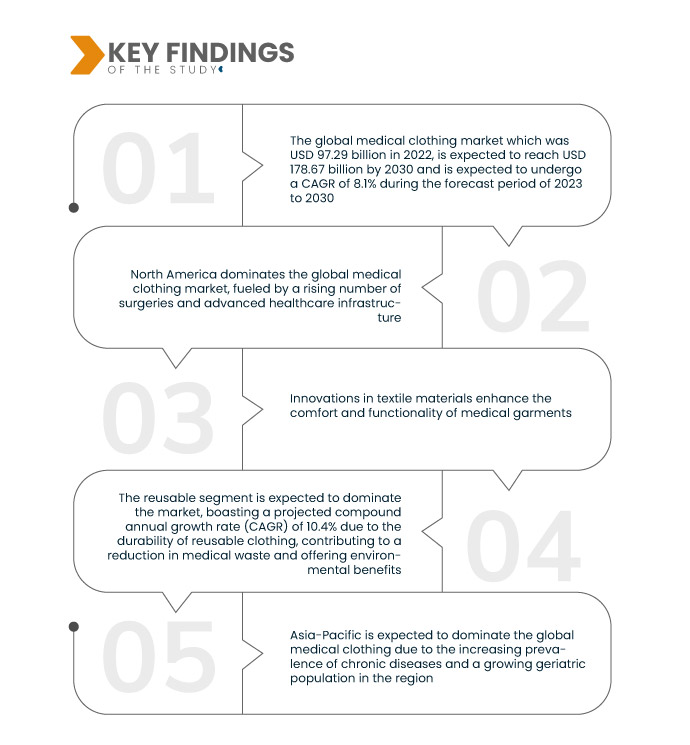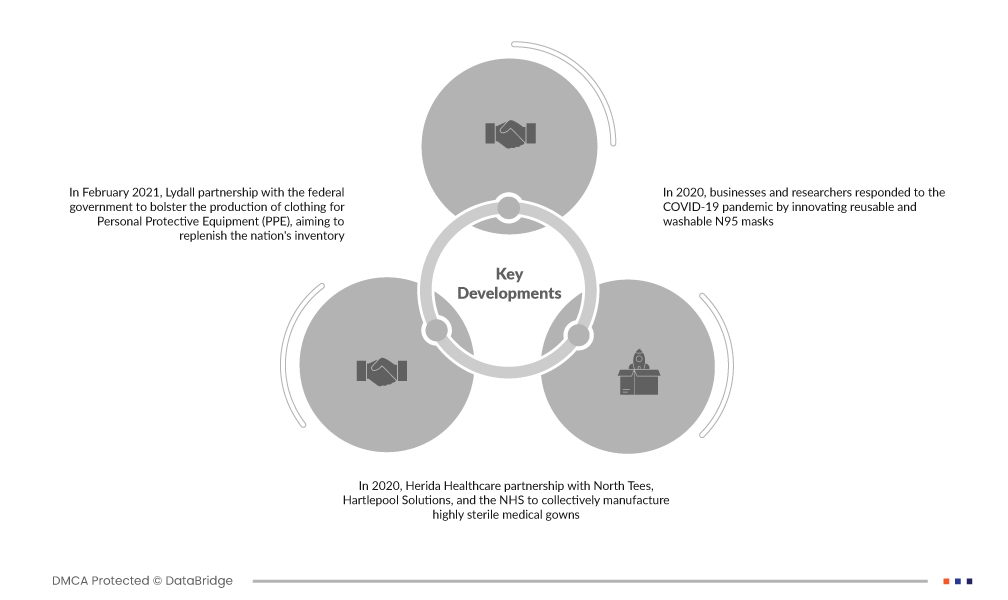의료복 시장은 병원, 전문 클리닉, 외래 진료소, 재택 치료 시설, 연구 및 임상 검사실 등 다양한 최종 사용자를 대상으로 합니다. 직접 입찰, 소매 판매, 제3자 유통업체 등 다양한 유통 채널을 통해 광범위한 영향력을 발휘합니다. 이처럼 광범위한 시장 역학은 여러 의료 환경에서 접근성과 가용성을 보장하여 의료 전문가의 다양한 요구를 충족하고 의료 산업의 다양한 용도에 맞는 특수 의류의 원활한 유통을 보장합니다.
전체 보고서는 https://www.databridgemarketresearch.com/reports/global-medical-clothing-market 에서 확인하세요.
데이터 브리지 마켓 리서치(Data Bridge Market Research)에 따르면 , 2022년 972억 9천만 달러였던 세계 의료복 시장은 2030년까지 1,786억 7천만 달러에 이를 것으로 예상되며, 2023년부터 2030년까지 연평균 8.1% 성장할 것으로 전망됩니다. 전 세계적으로 수술 건수가 증가하는 것은 의료복 시장의 핵심 성장 동력입니다. 수술 수요가 증가함에 따라 수술 가운과 보호복을 포함한 특수 의류에 대한 수요도 증가하고 있으며, 이는 의료 환경의 변화와 안전 요구 사항에 대한 시장의 대응력을 보여줍니다.
연구의 주요 결과
엄격한 안전 규정으로 인해 시장 성장률이 높아질 것으로 예상됩니다.
엄격한 안전 규정은 의료복 시장 성장에 중요한 역할을 합니다. 확립된 안전 기준을 준수하기 위해 의료 시설은 특수 복장을 도입하여 지침을 준수하고 의료 전문가와 환자 모두를 보호해야 합니다. 이러한 규정 준수 강화는 감염 관리 조치를 강화할 뿐만 아니라 안전한 의료 환경 유지에 있어 첨단 의료복의 중요성을 강조하여 안전 중심 의류 솔루션 시장의 성장과 혁신을 촉진합니다.
보고서 범위 및 시장 세분화
보고서 메트릭
|
세부
|
예측 기간
|
2023년부터 2030년까지
|
기준 연도
|
2022
|
역사적인 해
|
2021 (2015-2020년으로 맞춤 설정 가능)
|
양적 단위
|
매출(10억 달러), 볼륨(단위), 가격(USD)
|
다루는 세그먼트
|
제품(전문가용 의류, 환자용 의류, 특수 의류, 응급 처치복, 랩 및 타월, 기타), 사용(재사용 가능, 일회용), 최종 사용자(병원, 전문 클리닉, 외래진료센터, 재택 치료 시설, 연구 및 임상 실험실, 기타), 유통 채널(직접 입찰, 소매 판매, 제3자 유통업체, 기타)
|
포함 국가
|
미국, 북미의 캐나다 및 멕시코, 독일, 프랑스, 영국, 네덜란드, 스위스, 벨기에, 러시아, 이탈리아, 스페인, 터키, 유럽의 기타 유럽 국가, 중국, 일본, 인도, 한국, 싱가포르, 말레이시아, 호주, 태국, 인도네시아, 필리핀, 아시아 태평양(APAC)의 기타 아시아 태평양(APAC), 사우디아라비아, UAE, 남아프리카 공화국, 이집트, 이스라엘, 중동 및 아프리카(MEA)의 일부인 기타 중동 및 아프리카(MEA), 남미의 일부인 기타 남미 국가.
|
시장 참여자 포함
|
|
보고서에서 다루는 데이터 포인트
|
Data Bridge Market Research에서 큐레이팅한 시장 보고서에는 시장 가치, 성장률, 세분화, 지리적 적용 범위, 주요 기업 등 시장 시나리오에 대한 통찰력 외에도 심층적인 전문가 분석, 환자 역학, 파이프라인 분석, 가격 분석, 규제 프레임워크가 포함됩니다.
|
세그먼트 분석:
글로벌 의료복 시장은 제품, 용도, 최종 사용자, 유통 채널을 기준으로 세분화됩니다.
- 전 세계 의료복 시장은 제품 기준으로 전문가용 의류, 환자용 의류, 특수 의류, 응급처치복, 랩 및 타월, 기타로 구분됩니다. 전문가용 의류 부문은 연평균 성장률(CAGR) 10.6%로 시장을 주도할 것으로 예상됩니다. 이는 의사, 외과의, 간호사를 포함한 의료 전문가들의 건강 관리에 대한 우려가 증가하고 있기 때문이며, 의료 및 헬스케어 산업 내 의료진의 웰빙을 보장하는 데 있어 특수 의류가 중추적인 역할을 한다는 점을 강조합니다.
- 전 세계 의료복 시장은 사용 방식을 기준으로 재사용 가능 의류와 일회용 의류로 구분됩니다. 재사용 가능 의류 시장은 연평균 성장률(CAGR) 10.4%를 기록하며 시장을 주도할 것으로 예상됩니다. 이러한 성장세는 재사용 가능 의류의 내구성, 의료 폐기물 감소, 환경적 이점 덕분에 가능합니다.
2023년에는 사용 부문 중 재사용 부문이 글로벌 의료복 시장을 장악할 것으로 예상된다.
재사용 가능 부문은 10.4%의 연평균 성장률(CAGR)을 기록하며 시장을 주도할 것으로 예상됩니다. 이러한 우세는 재사용 가능 의류의 내구성, 의료 폐기물 감소 및 환경적 이점에 기인합니다. 시장의 재사용성 전환은 의료 의류 산업의 지속가능성과 효율성에 대한 중요성을 강조합니다.
- 최종 사용자 기준으로 전 세계 의료복 시장은 병원, 전문 클리닉, 외래 진료소, 재택 치료 시설, 연구 및 임상 검사실 등으로 구분됩니다. 병원 부문은 94.2%의 상당한 시장 점유율을 차지하며 시장을 장악하고 있습니다. 이러한 우세는 병원 입원 기간 단축을 통해 높은 비용을 절감하는 데 기여한 데 기인합니다. 효율성과 비용 절감에 중점을 둔 병원 부문은 의료복 시장 발전에 있어 중요한 동력으로 자리매김하고 있습니다.
- 유통 채널을 기준으로 글로벌 의료복 시장은 직접 입찰, 소매 판매, 제3자 유통업체, 기타 시장으로 구분됩니다. 직접 입찰은 직접 판매가 매출에 크게 기여함에 따라 10.0%의 주목할 만한 연평균 성장률(CAGR)을 기록하며 시장 선두주자로 부상했습니다. 이는 직접 입찰 부문이 시장에서 상당한 영향력과 성장을 보이고 있음을 보여줍니다.
2023년에는 유통채널 부문의 직접입찰 부문이 글로벌 의료복 시장을 주도할 것으로 예상된다.
직접 입찰은 10.0%의 주목할 만한 연평균 성장률(CAGR)을 기록하며 시장 선두주자로 부상했습니다. 이러한 지배력은 가장 큰 시장 점유율과 가장 높은 CAGR을 기록하는 데 특징이 있습니다. 특히 직접 판매는 매출에 상당한 기여를 하며, 시장 내 직접 입찰 부문의 상당한 영향력과 성장을 보여줍니다.
주요 플레이어
Data Bridge Market Research에서는 글로벌 의료복 시장의 주요 기업으로 Cardinal Health, Inc.(미국), Mölnlycke Health Care AB(스웨덴), 3M(미국), Smith+Nephew(미국), Ansell Ltd.(호주), Superior Group of Companies(미국), Semperit AG Holding(오스트리아), Henry Schein, Inc.(미국)을 꼽았습니다.
시장 개발
- 2021년 2월, 라이달(Lydall)은 연방 정부와 협력하여 개인 보호 장비(PPE)용 의류 생산을 확대하고 국가 재고를 보충했습니다. 이 전략적 파트너십은 코로나19 팬데믹으로 인한 지속적인 어려움 속에서 급증하는 PPE 수요를 충족하기 위한 공동의 노력을 반영하며, 공중 보건을 위한 필수 물자 확보에 있어 민간 기업과 정부 기관 간의 협력의 중요성을 강조합니다.
- 2020년, 헤리다 헬스케어(Herida Healthcare)는 노스 티스(North Tees), 하틀풀 솔루션즈(Hartlepool Solutions), 그리고 NHS와 협력하여 고도로 멸균된 의료용 가운을 공동 생산했습니다. 이 전략적 파트너십은 COVID-19 팬데믹 기간 동안 보호복에 대한 절실한 필요성을 해결하고, 필수 의료복 공급을 확대하고 전 세계적인 의료 위기 대응에 기여하기 위한 공동의 노력을 보여주었습니다.
- 2020년, 기업과 연구자들은 재사용 및 세척 가능한 N95 마스크를 혁신적으로 개발하여 COVID-19 팬데믹에 대응했습니다. 이 마스크는 기존 N95 마스크와 동일한 수준의 여과 및 보호 기능을 제공하면서도 재사용이 가능하다는 장점을 제공합니다. 철저한 세척 및 소독 후 재사용이 가능하여 폐기물을 최소화하고, 현재 진행 중인 보건 위기 동안 필수 보호 장비를 안정적이고 지속 가능하게 공급할 수 있습니다.
지역 분석
지리적으로, 글로벌 의료복 시장 보고서에서 다루는 국가는 북미의 미국, 캐나다 및 멕시코, 유럽의 독일, 프랑스, 영국, 네덜란드, 스위스, 벨기에, 러시아, 이탈리아, 스페인, 터키, 유럽의 기타 유럽, 중국, 일본, 인도, 한국, 싱가포르, 말레이시아, 호주, 태국, 인도네시아, 필리핀, 아시아 태평양(APAC)의 기타 아시아 태평양(APAC), 사우디 아라비아, UAE, 남아프리카 공화국, 이집트, 이스라엘, 중동 및 아프리카(MEA)의 일부인 기타 중동 및 아프리카(MEA), 브라질, 아르헨티나, 남미의 일부인 기타 남미입니다.
Data Bridge Market Research 분석에 따르면:
북미는 2023-2030년 예측 기간 동안 글로벌 의료복 시장에서 지배적인 지역입니다.
북미 지역은 수술 건수 증가와 선진 의료 인프라를 바탕으로 세계 의료복 시장을 장악하고 있습니다. 주요 시장 참여 기업들의 활발한 활동은 북미 지역의 시장 지배력을 더욱 강화합니다. 견고한 의료 시설과 업계 선도적인 입지를 포함한 이러한 요소들이 결합되어 북미 지역의 빠른 성장세를 견인하며, 의료복 시장의 발전과 확장을 위한 중추적인 역할을 하고 있습니다.
아시아 태평양 지역은 2023~2030년 예측 기간 동안 글로벌 의료복 시장을 주도할 것으로 예상됩니다.
아시아 태평양 지역은 2023년부터 2030년까지 세계 의료복 시장을 주도할 것으로 예상됩니다. 이러한 전망은 만성 질환 유병률 증가와 고령 인구 증가에 기인합니다. 증가하는 의료 수요와 변화하는 인구 통계는 의료복 수요를 뒷받침하며, 아시아 태평양 지역은 예측 기간 동안 시장 성장에 크게 기여할 것으로 예상됩니다.
글로벌 의료복 시장 보고서에 대한 자세한 내용은 여기를 클릭하세요 - https://www.databridgemarketresearch.com/reports/global-medical-clothing-market












